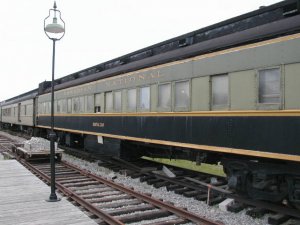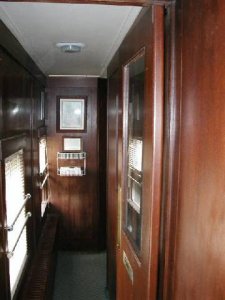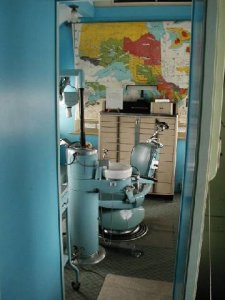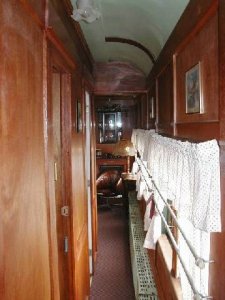This is the Smith's Falls Railway Museum's Dental Car. See the related thread started by Matthyro.
Dental Car
- Thread starter MasonJar
- Start date
You are using an out of date browser. It may not display this or other websites correctly.
You should upgrade or use an alternative browser.
You should upgrade or use an alternative browser.
The dental car is owned by John Weir of Carleton Place. This has been a labour of love for John. I've spent many an afternoon chewing the fat with John and discussing how he's discovered the history of the car, which dentists and nurses worked in it and where it travelled to.
He's also managed to get a bit of a reunion of dentists and nurses going so that they can reminisce about their experiences.
The dental equipment was donated by those same dentists who scrounged the countryside to find equipment that closely represented what was used in that car at the time.
The dental cars would be hauled from town to town or siding to siding in Northern Ontario. It would be parked on the siding for a few days or a week at a time. The patients would come into the car at one end (there's a neat waiting room at the other end of the car) and they would have their teeth checked, cavities filled, and other dental things.
The car was completely self-sufficient with living, dining and sleeping quarters, including rooms for a nurse.
He's also managed to get a bit of a reunion of dentists and nurses going so that they can reminisce about their experiences.
The dental equipment was donated by those same dentists who scrounged the countryside to find equipment that closely represented what was used in that car at the time.
The dental cars would be hauled from town to town or siding to siding in Northern Ontario. It would be parked on the siding for a few days or a week at a time. The patients would come into the car at one end (there's a neat waiting room at the other end of the car) and they would have their teeth checked, cavities filled, and other dental things.
The car was completely self-sufficient with living, dining and sleeping quarters, including rooms for a nurse.
This is from a handout that John had done (I did a bit of editing on it).
***Dental Service in Remote Areas***
Few people are aware that in the early decades of the twentieth century, there were programs which provided free health care to people who didn't have ready access to medical services. The children of Northern Ontario was one group who benefited from these programs. This part of the province was a vast unsettled area, largely deprived of roads, with communities too small to afford the medical care we take for granted today.
***Start of the Dental Car Program***
The Ontario Department of Public Health turned to the Canadian National and Canadian Pacific Railways for help in starting a free dental service for these isolated communities in Northern Ontario. The answer was the Railway Dental Car. Service started on September 29th, 1931. Funding for the dental equipment was donated by the "Imperial Order of the Daughters of the Empire" (IODE), Rosedale (Toronto) Chapter.
The dental cars, each staffed by a dentist and dental assistant, were moved by train and parked in each community from six weeks to five months, depending on the demand for services. Each car was self-sufficient with a waiting room, an examination room, a dark room for developing x-ray photos, kitchen, bathroom, living room, and two bedrooms. Supplies and fuel oil were kept in a converted mail car that travelled with the dental car. The dental cars were set up for three separate power systems: a regular 110 volt system if the local community had electricity), a generator-battery system if the community didn't have electricity, and regular train power when the car was being moved between communities.
The Railway Dental Car program was ended in 1977 when this car was retired in favour of highway dental trailers. Today, a limited highway dental service remains. The success of this program can be attributed not only to the railways and the Ontario Department of Public Health, but in particular to the dentists and their wives/assistants who lived and worked in these cars. These truly dedicated professionals possessed the special ability to deal with one challenge after another, in what many people would consider very confined and isolated conditions. It is to the memory of these special people that this Railway Dental Car is dedicated.
***"The Camrose"***
The Canadian National Dental Car on display at the Smiths Falls Railway Museum is a former sleeping car that was built in 1913 by the Barney & Smith Car Company, Dayton, Ohio for the Canadian Northern Railway. First numbered as #1343, the car was wooden with a wooden underframe. The interior was constructed from inlaid South American mahogany which is noted for its reddish brown colour and tight grain - ideal for the fine interior work in "First Class" sleeping cars. The curved walls and beamed ceilings were characteristic of Barney & Smith passenger cars. Much of this workmanship remains in this car.
With the takeover of the Canadian Northern by the newly-formed Canadian National Railways, the car was renumbered from #1343 to #1444, and named "Camrose" after the town of Camrose, Alberta in 1921. This car was one of series of cars to be named after towns in Western Canada. Concurrently, the car got a steel underframe and steel sheathing to bring it up to standards of the time. Although no records are known to exist, it is reasonable to assume that the "Camrose" accumulated over a million miles of revenue service, probably between Winnipeg, Manitoba and the west coast. In the process, it undoubtably provided "first-class" sleeping accommodation to passengers numbering in the thousands over a period of nearly 40 years.
Canadian National retired the "Camrose" from active service in 1951. Instead of being scrapped, the car was converted to a dental car. This car was the third and the last in a series of cars that were used in providing dental service to the children of Northern Ontario. In 1977, the "Camrose" was retired from dental service. The car was transported to the museum in the summer of 1990.
***Selected Information Sources***
A Century of Deluxe Railway Cars in Canada, Wayner, R.J.
The Barney and Smith Car Company, Trostel, S.D.
Canadian Trackside Guide, Bytown Railway Society Inc.
***Dental Service in Remote Areas***
Few people are aware that in the early decades of the twentieth century, there were programs which provided free health care to people who didn't have ready access to medical services. The children of Northern Ontario was one group who benefited from these programs. This part of the province was a vast unsettled area, largely deprived of roads, with communities too small to afford the medical care we take for granted today.
***Start of the Dental Car Program***
The Ontario Department of Public Health turned to the Canadian National and Canadian Pacific Railways for help in starting a free dental service for these isolated communities in Northern Ontario. The answer was the Railway Dental Car. Service started on September 29th, 1931. Funding for the dental equipment was donated by the "Imperial Order of the Daughters of the Empire" (IODE), Rosedale (Toronto) Chapter.
The dental cars, each staffed by a dentist and dental assistant, were moved by train and parked in each community from six weeks to five months, depending on the demand for services. Each car was self-sufficient with a waiting room, an examination room, a dark room for developing x-ray photos, kitchen, bathroom, living room, and two bedrooms. Supplies and fuel oil were kept in a converted mail car that travelled with the dental car. The dental cars were set up for three separate power systems: a regular 110 volt system if the local community had electricity), a generator-battery system if the community didn't have electricity, and regular train power when the car was being moved between communities.
The Railway Dental Car program was ended in 1977 when this car was retired in favour of highway dental trailers. Today, a limited highway dental service remains. The success of this program can be attributed not only to the railways and the Ontario Department of Public Health, but in particular to the dentists and their wives/assistants who lived and worked in these cars. These truly dedicated professionals possessed the special ability to deal with one challenge after another, in what many people would consider very confined and isolated conditions. It is to the memory of these special people that this Railway Dental Car is dedicated.
***"The Camrose"***
The Canadian National Dental Car on display at the Smiths Falls Railway Museum is a former sleeping car that was built in 1913 by the Barney & Smith Car Company, Dayton, Ohio for the Canadian Northern Railway. First numbered as #1343, the car was wooden with a wooden underframe. The interior was constructed from inlaid South American mahogany which is noted for its reddish brown colour and tight grain - ideal for the fine interior work in "First Class" sleeping cars. The curved walls and beamed ceilings were characteristic of Barney & Smith passenger cars. Much of this workmanship remains in this car.
With the takeover of the Canadian Northern by the newly-formed Canadian National Railways, the car was renumbered from #1343 to #1444, and named "Camrose" after the town of Camrose, Alberta in 1921. This car was one of series of cars to be named after towns in Western Canada. Concurrently, the car got a steel underframe and steel sheathing to bring it up to standards of the time. Although no records are known to exist, it is reasonable to assume that the "Camrose" accumulated over a million miles of revenue service, probably between Winnipeg, Manitoba and the west coast. In the process, it undoubtably provided "first-class" sleeping accommodation to passengers numbering in the thousands over a period of nearly 40 years.
Canadian National retired the "Camrose" from active service in 1951. Instead of being scrapped, the car was converted to a dental car. This car was the third and the last in a series of cars that were used in providing dental service to the children of Northern Ontario. In 1977, the "Camrose" was retired from dental service. The car was transported to the museum in the summer of 1990.
***Selected Information Sources***
A Century of Deluxe Railway Cars in Canada, Wayner, R.J.
The Barney and Smith Car Company, Trostel, S.D.
Canadian Trackside Guide, Bytown Railway Society Inc.
Interesting photos MasonJar.
You just never know what railroad cars were used for at one time or another in their lifetime.
You just never know what railroad cars were used for at one time or another in their lifetime.
Thanks Andrew, and others involved, a great intresting thread
Next please Plenty of laughing gas hahaheheheahahahahhhehh
OUCH~~~~~~````
Next please Plenty of laughing gas hahaheheheahahahahhhehh
OUCH~~~~~~````
Thanks for that additional information Bob.
Hard to believe that parts of that car will be 90 this year! The interior is in pretty good shape, and the woodwork is still beautiful.
Andrew
Hard to believe that parts of that car will be 90 this year! The interior is in pretty good shape, and the woodwork is still beautiful.
Andrew
i remember taking pics of this car when it was part of the harbourfront display in Toronto , early 80s, late 70s, then I saw it again sitting on tracks by Fort York and hobos and street people were living in it. I took pictures then it was gone. I saw it years later in Smith Falls, glad to see it got a new home there
Very interesting information Andrew and Bob! I wouldn't mind seeing it sometime, provided the dentist is NOT IN!!!! 
Val
Val
One neat thing about getting new members in is that they dig up all kinds of neat stuff you completely forgot you posted... Thanks Stuart!
Val - The Smith's Falls museum is worth a look for sure. If you ever head this way, let me know...!
Andrew
Val - The Smith's Falls museum is worth a look for sure. If you ever head this way, let me know...!
Andrew
well a friend mike and I are planning to be in smith falls some saturday or sunday soon. use to go there all the time when i lived in renfrew before I moved to Iowa....and got married, now divorced and single and back in the valley for a bit I will be in the falls to see trains i will go by and check out things , will bring pictures of the dental car as it sat on the tracks in toronto with me
Chessie6459
Gauge Oldtimer
That's cool. Thanks for sharing the photo's 

Would like to go and see the dentist car, but there is that fear i have of going to dentist office, just have to get over that and i would be fine LOL



Would like to go and see the dentist car, but there is that fear i have of going to dentist office, just have to get over that and i would be fine LOL
"... a pain to model....." Pulleeeze, don't make me groan so much.
Best to drop by the SFRM after the May 24th weekend to ensure that the Museum will be open. While many of us are there doing work on a Saturday or a Sunday, you take your chances if you drop by on a Saturday or a Sunday before then as we aren't open to the public. If you do drop by, ask for Bob (me). Or send me an e-mail and I can arrange to meet you at the Museum.
I was in the dental car yesterday (we were open for the March break school holiday) and it's still the same. Now, here's a secret. Some of the wood in those photos above aren't original. John Weir has renovated and installed new pieces. Can you tell which photos contain the original wood and which photos contain new wood?
MasonJar hasn't shown you photos of the Dentist's bedroom, the Nurse's bedroom, the Nurse's office. Just make sure you keep your elbows tucked in.
An interesting fact. The dental cars were replaced by buses and tractor trailers as it was felt that this new mode of tranportation would be quicker and cheaper. After one year, the costs of the new buses and tractor trailers and tripled the cost of the service.
Best to drop by the SFRM after the May 24th weekend to ensure that the Museum will be open. While many of us are there doing work on a Saturday or a Sunday, you take your chances if you drop by on a Saturday or a Sunday before then as we aren't open to the public. If you do drop by, ask for Bob (me). Or send me an e-mail and I can arrange to meet you at the Museum.
I was in the dental car yesterday (we were open for the March break school holiday) and it's still the same. Now, here's a secret. Some of the wood in those photos above aren't original. John Weir has renovated and installed new pieces. Can you tell which photos contain the original wood and which photos contain new wood?
MasonJar hasn't shown you photos of the Dentist's bedroom, the Nurse's bedroom, the Nurse's office. Just make sure you keep your elbows tucked in.
An interesting fact. The dental cars were replaced by buses and tractor trailers as it was felt that this new mode of tranportation would be quicker and cheaper. After one year, the costs of the new buses and tractor trailers and tripled the cost of the service.





